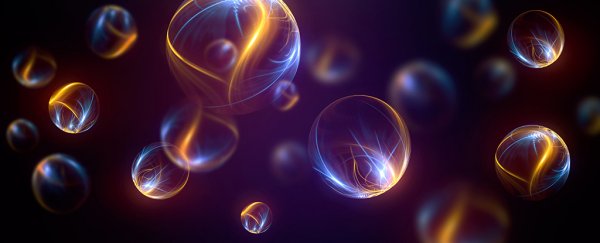A type of force that makes molecules briefly stick to one another has been shown to have a more repulsive side, even when they aren't being squeezed together.
Since first being described in 1930, van der Waal forces have been regarded as mostly attractive, only pushing back when groups of molecules are under pressure. New research predicts such a reversal can occur in the real world where crowds of molecules jostle freely, an idea that could affect how we approach everything from protein folding to nanotechnology.
By applying a model that mimicked how the charges on particles become polarised under certain conditions and then comparing their findings with experimental results, the researchers showed van der Waal forces can push when they were only expected to pull.
To get a better idea of exactly what this means, it helps to understand that van der Waal forces are like the little brother to the bonds that connect atoms to one another.
While reality is a little more complex, think of electrons as negatively charged particles that move around a positively charged nucleus. As they move, they're often more likely to occupy some areas around the atom more than others, depending on what else happens to be pushing and shoving nearby.
That's referred to as an electron charge density.
Molecules that have atoms of mismatched sizes, such as water with its tiny hydrogen atoms and rotund oxygen, can have an unbalanced game of tug-of-war over their shared electrons, leading to just such a bunching up around the molecule.
Keeping in mind that particles of the same charge have a repulsive effect on one another, electrons that 'bunch up' make that part of a molecule more negative, so they pull towards the zones of other molecules that are left more positive.
This loose bonding is why the molecules of H2O tend to stick more to each another, giving the liquid a high surface tension that makes belly-flops in the swimming pool hurt so much.
Van der Waal forces are like these so-called hydrogen bonds, but happen in molecules that aren't quite so imbalanced. Rather than a tug of war, electrons that randomly bunch up in one area briefly push away electrons on another atom nearby, creating a fleeting connection.
Compared with other forms of chemical bonding, including hydrogen bonds, van der Waal forces aren't exactly all that powerful, and require molecules to be relatively close to one another.
"The textbooks so far assumed that the forces are solely attractive. For us, the interesting question is whether you can also make them repulsive," says researcher Alexandre Tkatchenko from the University of Luxembourg.
Squeezing molecules close together can make their electron charge density shift, causing the molecules to repel one another.
Most models on van der Waal forces are based on pairs of molecules interacting in free space. The researchers wanted to know if the same rearrangements of electrons could sometimes be repulsive under other crowded conditions that weren't under high pressure.
The pair used a model called a Drude oscillator to mimic the fluctuating charge densities around particles in a confined space. approached the interactions as quantum systems based on waves rather than the more traditional many-body dispersion framework that relied on particles.
Their novel quantum-mechanical method fitted what they observed better than previous explanations, demonstrating that the tiny tugs between molecules over short distances can sometimes turn into the occasional shove, even when they're not being squeezed together.
"We could rationalise many previous experimental results that remained unexplained until now. Our new theory allows, for the first time, for an interpretation of many interesting phenomena observed for molecules under confinement," says researcher and developer of the model, Mainak Sadhukhan.
Though fleeting and tiny, van der Waal forces are collectively bonds to be reckoned with, especially in complex chemistry that involves diverse molecules such as those inside our cells.
Not only is it academically interesting that the forces can sometimes push, it could have implications in how we develop new pharmaceuticals, approach desalination technology, or even move molecules around in new forms of nanotech.
This research was published in Physical Review Letters.
